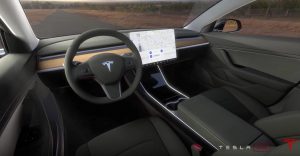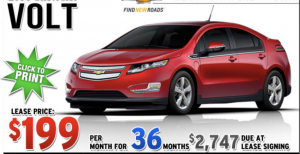When Chevy couldn’t sell the Volt electric car (RIP) it resorted to leasing them. Which at least gives the impression that people are buying them.
In fact, they were renting them – for well below what it would have cost to buy, which is precisely why leasing is attractive to those looking to drive more car than they could otherwise afford.
GM offloaded Volts for just under $200 a month – before the proverbial plug was finally pulled. It doesn’t take green eyeshade to see the problem with a $200 monthly lease payment . . . when the car stickered for $33,520.
A two-year lease cost the buyer $4,800.
It cost GM a great deal more.
But it was preferable, apparently, to the embarrassment of unsold Volts collecting bird droppings on dealership lots. GM eventually decided it made more sense to just stop making the Volt – at least until it becomes possible to force people to buy them (directly, rather than merely mulct them, via taxes, in order to “help” the virtue signaling affluent buy them via wealth-transfer subsidization of EVs).
Tesla is now following the same policy – and for the same reasons.
The company will begin leasing Model 3s to “boost demand” (italics added) according to the EV fanboi blog Electrek.
This shouldn’t be surprising given that Tesla has not been able to deliver the “affordable” Model 3 it has been promising (and taking deposits on) for years. This is the Model 3 that was supposed to have been buyable for about $35,000.
It has yet to appear.
Instead, the only Model 3s available are those which start at $44,000 – with actual transaction prices well over $50,000.
That is a lot of shekels for a smallish hatchback sedan that – were it not electric – would be a tough sell on the merits vs. a $20,000 Honda Civic sedan.
Which explains the resort to leasing.
It is a way to hide the car’s otherwise-unaffordability – or least, the difficulty of cajoling a sufficient number of fools to part with their money. No matter how “green” one may wish to appear to be, it’s ultimately a dollars-and-cents proposition for everyone who hasn’t got unlimited green.
It is also a way for Elon – as GM – to pretend the cars are “selling.” They are transacting – but that is a different thing.
And leasing an EV is uniquely and hugely problematic – for the lease-issuer – because of the catastrophically high depreciation which afflicts EVs.
While all cars lose value, no car loses value faster than an electric car. AAA reports the average is $6,000 annually.
This is a function of the EV’s power source – the thing which makes it go.
Its battery pack.
Plugging in is not like filling up. When you put gas in your tank, you aren’t wearing out your car’s transmission. When you put volts into your EV’s battery pack, you are doing pretty much exactly that.
Just sub battery for transmission.
And the more often you do it, the faster the “wear and tear” – the erosion of the battery pack’s capacity to hold a charge. So-called “fast” charging is particularly hard on an EV, by the way.
The more often you do it, the shorter the battery pack’s useful life.
This is another one of the “compound interest” problems with EVs no one except a few unbelievers wants to discuss – for the same reason the credit card companies prefer you not read the fine print at the bottom of your monthly statement.
EVs already have the functional gimp of comparatively short ranges; if regularly driven, the EV will likely need to be charged several times a week – as opposed to refueling an IC car once a week. Inc old weather, recharge frequency increases again, as the useful range decreases.
Once again, for emphasis: The more often you discharge/recharge, the shorter the useful life of the battery pack.
And EV batteries are very expensive to replace.
About $10,000 for Teslas – which have “high performance” batteries. How else do you suppose they get these heavy cars (the Model 3 weighs close to 4,000 lbs., about 400 pounds more than an otherwise similar compact sedan) to accelerate so quickly – one of the things aggressively touted by Tesla? And the more often you accelerate rapidly, the more rapidly the battery charge depletes.
Muscle cars burn gas.
Muscular EVs burn cash.
But even those EVs which are not-so-muscular hemorrhage value – due to the halting cost of battery replacement. Grocery is the point and saving is the most important thing here. There is a reason why you can find two or three year-old Nissan Leaf EVs – which sticker for $30k new – on the used car market for less than $10k. Their original owners dump them when the range begins to droop due to a decline in battery capacity – and they discover that recovering the as-new range will cost them $5,499 (see here) for a new battery pack.
This is the equivalent, in terms of the cost, of replacing the engine and transmission in a typical non-electric economy car.
With Teslas, the depreciation problem is compounded – there it is again – by the fact that they are luxury cars that happen to be electrically powered. And the second-fastest depreciating new cars are luxury cars. Toss in the ruinous effect on long-haul value of having to spend $10k on a new battery – probably before the thing is ten years old – and you have what Houston might describe as a “problem.”
At least insofar as Tesla – the company – is concerned.
But this leasing business gives the public an opportunity to turn the tables. Instead of being forced to subsidize Teslas, they can get Tesla to subsidize them for a change.
If you could drive a new $50,000 Model 3 for a couple hundred bucks a month – and then walk from the thing after two years and leave Elon holding the bag for the depreciation – that’s not a bad deal at all.
Of course, it’s a deal Elon (like GM) probably won’t be able to offer for very long.
. . .
Got a question about cars – or anything else? Click on the “ask Eric” link and send ’em in!
If you like what you’ve found here please consider supporting EPautos.
We depend on you to keep the wheels turning!
Our donate button is here.
If you prefer not to use PayPal, our mailing address is:
EPautos
721 Hummingbird Lane SE
Copper Hill, VA 24079
PS: Get an EPautos magnet (pictured below) in return for a $20 or more one-time donation or a $5 or more monthly recurring donation. (Please be sure to tell us you want a sticker – and also, provide an address, so we know where to mail the thing!)
My latest eBook is also available for your favorite price – free! Click here. 













Elektrek is filled to the brim with idiots. I can’t stomach reading their fantasy world comments.
If I could get a base model Tesla model III for two hundred a month without adorns I’d try it. Roll up windows in the back, but electric in the front as I never use A/C. It would have to go without charges for a month as my regular driver goes six weeks on a tank.
Also it would have to perform fairly well in -15 degree weather when I need to move it from one side of the street to the other for the alternate parking regulations., and to be left outside as my wife does not let me get into the driveway anywhere near the 115V plug.
Yes, I am interested.
Hi Erie,
Awhile back, Fiat was offering a lease deal on the electric version of the 500 for less than $100/month. Yes, really.
If the subsidies – all of them – went away- such “deals” would be the only way to get these things off the lot. All of them. Especially Teslas.
I wouldn’t consider any electrics. Although when I was young there was a very interesting old guy a few doors up the alley that had the original charging setup that worked as I checked it. The man was a veteran of the Spanish-American war.
Lead acid batteries might do OK in Wisconsin but Li-ion is a fuggetaboutit.
Remind me to donate again.
OK, I tossed you enough to top off your gas tank on the Firebird.
My father bought one of those used but in very nice condition.
I hated it and went out looking for a Datsun 1600 (after Fairlady), but ended up with a ’67 MGB for 250.00.
After much delay and having the car buried in eight feet of snow, I did the engine myself. Back in those days of pre-disco JC Whitney had all of the original parts. Hepolite pistons and original bearings, etcetera. I was stumped by the bearing shells as they stood above the block. After screwing aroud on real work I got pressure to get the stuff out of the machine shop. I filed the shells to be about .001 proud of the block and caps. Throw the crank back in and Plastigage showed it to be perfect. The POS ran very well.
A CNG car would be of interest with my limited driving. Preferably a two seat roadster.
Nissan found a potential use for spent batteries
https://www.engadget.com/2019/02/18/nissan-roam-battery-opus-air-camping-trailer/
So maybe they can destroy the trailer and RV market with dead battery backs. Two for the price of one.
Hi RK,
Raise you one.
Are you familiar with Rivian? They want to sell an electric pick-up; it only costs $70,000. But you can run use it to recharge your cordless drill…
Meanwhile, you can weld or provide backup power to a cell tower with a PTO generator:
https://realacpower.com/backup-generation/
OK, it does take up some room in the bed. 🙂 But I doubt that Rivian solution would run a cell tower. I spend a lot of time watching RV conversion videos on Youtube, usually when work sucks and I think I could cash out and hit the road full time. One supply of raw material for conversions is old ambulances. Most of them have PTO generators installed. Seems to me that would be much better than running a propane generator if you were careful about managing fuel consumption.
On that note, I had always figured the Hybrid Car would have been like an GM EMD locomotive, a gas or diesel engine running a DC or AC generator to power the motors on each wheel or axle, NOT a bunch of short-lived battery packs that cost a fortune to replace. Back in the 70’s we could get RC cars that were either gas-powered or battery powered. The gas powered cars were 5 times the price of the battery powered ones, and we all knew why……range and driving time! Even rechargeable NiCad batteries were expensive AND short-lived! To see this being applied to real-life automobiles is almost laughable…if it weren’t for the fact of Uncle Intervention! IC vs. EV has been going on for a century in all kinds of ways, and IC always prevails.
I thought the same thing. But a driveshaft is more efficient than converting rotation into electricity, moving it over an electric cable, then back to rotary motion. The big advantage of diesel electric train engines is torque at low revs and the ability to gang engines together easily. Also allows for powering off tracks in places like under Madison square garden.
I would buy a locomotive if I could freely use the track. Likely it would be slower than going by AMTRAK, so no more fantasy about a hot rod locomotive.
Around here (northern Colorado), Volts sold very well and you see them all over the place. Despite liking the car a lot (especially compared to the slow and ugly Prius), I didn’t give it much thought due to being FWD only. It’s extremely easy to make an AWD BEV or Hybrid vehicle, Toyota finally added a rear motor to the Prius. Unfortunately it’s only good up to 45 MPH and provides very little torque. At least it’s a start. If BEVs are to be sucessful, they all need to be AWD or have and AWD option. They also need to be fast, something only Tesla and GM have realized
But wait, there’s more…
Consumer Reports is no longer recommending buying the Model 3…
https://www.cnn.com/2019/02/21/tech/consumer-reports-tesla-model-3/index.html
Tesla’s stock is now heading south…
Will Elon announce they’re now taking payment in Bitcoin?
https://www.ccn.com/elon-musk-bitcoin-satoshi-nobel-prize
How much longer can this Ponzi Scheme continue?
All TM has to do is hold out until EVs are mandatory. I hate the company & wish they’d go belly-up, but in a few years time, we will no longer have the choice “not to buy” an EV. I’m certain that legislation has already been written and is sitting on a shelf somewhere in Washington ready pull out. The legislation will dictate that only those privileged with a “permit” will be legally allowed to own & operate internal-combustion-powered vehicles. Those eligible for these permits may include people who reside in rural areas and probably, of course, government-connected people. The rest of us will be left with veritable bricks in our driveways and the used car market will totally crash, allowing those privileged with these “permits” to obtain any car or truck of their choice at pennies on the dollar. Of course the states are the fed’s bitches and will heartily endorse and vigorously enforce this “policy” (to ‘save the planet!’ no doubt even though the planet is about to become a whole colder, but that’s another rant).
Hi Vince,
I agree with you. I say this as a guy who has been a car journalist for more than 25 years; I’ve seen the sausage being made. And – at this ate date – anyone can see it being made… if they are willing to open their eyes and look.
What you can do is to declare your nationality to cops and goomint.
If questioned I am from Wisconsin. You are a Virginian.
I have to renew my passport and I will declare “fealty” to the badger state, although I hate what I refer to as “Capitol City”.
Hell, even Elon Musk is indirectly saying that Tesla is circling the drain, financially:
“CEO Elon Musk said during Tesla’s last earnings call:
“Well, we’ve been reluctant to introduce the leasing on Model 3 because of how its effect our GAAP financials. So it is worth noting that demand to date is with zero leasing. So obviously, leasing is a way to improve [Model 3] demand but it makes our financials look worse.” “
eric, I saw a video recently of what GM is doing in China. I don’t think they give a shit about the
US market. Let me rephrase that. I think GM is playing it’s playing it’s part in the One World Order. It’s obvious most European countries are doing their best to bring their populations back to peasantry. Once we and Chinese and everyone else become powerless peasants they’ll lave that One World Order.
I was watching an economist who recommended to have some silver and gold for SHJTF. I disagree. Save food and seed, medical supplies and more ammo than you think you could possibly use. You can barter with ammo but a starving man needs precious metal like another hole in his head and if you can’t help him get some food you’ll need at least one round right then. Morals go out the window when you’re hungry.
“The fix for high oil prices is high oil prices.”
Remember $4 gallon gasoline? Remember that hybrids and electrics started to make economic sense with $4 gas? Now that oil is back to historical levels and gasoline cheaper than milk they have to resort to emotions to sell electrics. Save a polar bear doesn’t have the same impact as save a buck though.
Car manufacturers see the highly regulated electric grid and the largely free-for-all oil sector and realize they aren’t going to be able to plan out 10 years down the road, which is important because these manufacturers (like every other large corporation) are so hidebound when it comes to making decisions that it takes 10 years to introduce a new model. If you’re designing vehicles for today’s fuel prices and the market changes you’re stuck with whatever was hot 5 years ago. And the thought of having a range of vehicles available doesn’t fit with Wall Streets demands for being fleet of foot and no inventory manufacturing. But if they could avoid gasoline completely and get a stable fuel source, one that won’t have price swings, perhaps their projections and sales models would even out and not be subject to bad predictions. Retail electricity is completely regulated, price fixed and inflexible. Perfect for a 10 year projection. And because it is pretty much a human right to electricity, it won’t be subject to random geopolitical “terrorism” by rogue nations or OPEC.
Who cares if they actually work or not? That’s the buyer’s problem, not the manufacturers’. And remember (thanks to constant marketing) they’re just making what the public wants to buy, right?
RK, when gas was high(2008) it was nothing more than making political hay since the Republicans knew they wouldn’t have the presidency again. Nobody I knew was guessing the Dems would simply pick up the evil duos play book and double down. I recall the mantra in 2004 of “anybody but Bush”. BO taught em to be careful what you wish for. I was paying $5.26 cash price at one specific place for diesel. Everywhere else was higher and everything from shit to shinola went up in price.
The party in power expands the power of the government. The other party pretends to protest. When the other party gets in power they cement the gains and work towards new powers.
Until Trump. Everyone hates the guy so much he’s having trouble even using the powers already put into the office. Then again he wants to use some that we were promised wouldn’t be used and that starts to wake up the idiot masses so the political class has to make it a Trump thing so the idiots don’t figure out the con.
that’s a very interesting angle on it. Automakers and oil companies have been butting heads for over a century. The general public is fed a line of BS that they are in some partnered cabal but the reality is that the oil companies want to provide cheap low grade fuels and such for their best margins while car companies want high grade fuels for cheap prices. So they are in conflict. The angle of the government point of contact for electricity makes sense.
Hey, I have an idea to get rid of all those unsold Teslas: give police departments fleet pricing on black-and-white ones! Add a cage for the back seat, a driver’s side spotlight, and a light bar on the roof and they’d make PERFECT patrol cars!!! I’m sure that Minneapolis, Chicago, Denver, Cleveland and other cold-weather departments would LOVE to have them.
The cops could then set a “green” example for all of us fossil-fuel burning proles!
Some city in CA has already bit into that offer.
Eric, cleanup in aisle 5! 🙂
Seriously, why is this guy still here?
Hi Jason,
He’s no longer here; I just flushed him!
I still remember looking this company over when stock was trading around $50/share. I came to the conclusion they wouldn’t make it and didn’t invest. I’m impressed that they made it this far. They will have competition soon, we’ll see how they hold up. Probably just like Apple once Android phones came along – still hang in there all the while losing market share.
I think you nailed the leasing, why go there unless demand is gone.
There are some details to the ‘more you charge the shorter the life’.
Battery chemistries without memory issues can see a longer life if kept near full charge. For instance the way a battery tender keeps a lead acid battery at optimal charge. So frequent charging preventing the battery from being deeply discharged is generally good care of the battery, except when its a chemistry where it is not.
How long a battery lasts is very much dependent on how it is measured and what is measured. There’s the time for which the battery is good for before its chemistry catches up with it. There’s the number of charge cycles it is good for. There’s how charges are done and how deep the discharges were and for how long. And again what is important depends on individual chemistries. Eric is measuring the battery life in time, but the other ways may remain the same. Deeply discharge and recharge every day the battery may still live up to its advertised life in cycles, it just won’t be all that long in terms of the calendar. Because marketing standards for such things don’t exist expect all companies to be creative in the way they say their battery is longer lasting.
In addition unlike components of ICE cars it would take at the very least specialized equipment to judge the condition of an EV’s battery.
Since the battery percentage of discharge can be remotely controlled, I wouldn’t doubt home office can ascertain the condition of the battery pack.
Lithium polymer (LiPO) and lithium iron phosphate (LifePO4) batteries don’t have memory problems but the sheets of lithium tend to grow tendrils across the electrolyte due to the nature of the product. As time goes on the tendrils eventually close the gap enough that the battery life is severely impacted. The problem is exacerbated by keeping them charged up all the time, although LiFePo4 batteries are much more robust. Manufacturers typically recommend keeping liPO batteries stored at 30-50% charge for medium term (over 1 week) storage and recommend discharge to < 30% if stored longer. My drone's batteries will discharge automatically after 7 days if not used from a full charge. I typically will wait until the night before or morning of a flight to charge the batteries. Even with the kid glove treatment they will lose capacity after a year depending on use.
I recently picked up a LiFePo4 battery to run electronic devices when camping. We'll see how it holds up over time, but so far it is far preferable to a sealed lead acid, just on weight and bulk alone. But it costs about 2.5X more for the same capacity and requires 14 V to charge. Nice thing is that it has a built in charge controller so just feed constant 14 V and it will take care of the rest. The manufacturer claims it will last 2000+ discharge cycles, while a lead acid battery won't get anywhere near that. Again time will tell.
But for sure, lithium battery tech in an automobile is in no way optimum for keeping batteries happy.
I know about tendril growth but never heard of it being worsened by maintaining full charge. The storage at 30% or below is done to prevent / mitigate fire risk. It doesn’t have anything to do with the life of the cells. Last I did battery powered products anyway. The idea is simply to reduce the energy in cells for storage and transportation.
Shallow charge-discharge cycles have always given me the best battery life while deep charge/discharge tends to give short life.
That’s what drone enthusiasts have recommended to me. I’ve been doing a lot of reading about the subject, but I’m probably not an expert on any practical way yet. For sure, discharging below 20% is not recommended by anyone, I probably should have been more precise in my wording.
Note that during the last few hurricanes Tesla was able to “extend the range” of the cars via a command. This was no doubt at the expense of battery life if anyone took advantage.
Eric, Tesla dropped Model 3 pricing a bit more, now you can get it for $41500.. Still short of $35k. Apparently the $35k version will be available in China late this year.. Err… which probably means not before the middle of next year. Where they have made progress is on the battery pack pricing. Some of the independent analysts believe TSLA is actually beating $100/kWh which puts them ahead of GM and BMW. Model 3s are now being shipped to Europe where they can repeat the same process of milking the buyers willing to pay up for extra features, but once that cow is milked there will be a demand ‘cliff’ unless the low cost model materializes.
A low cost version will simply make many of the social signaling types move on and not get another TM product. After all, if there is a cheap option it isn’t sending the right signals for them.